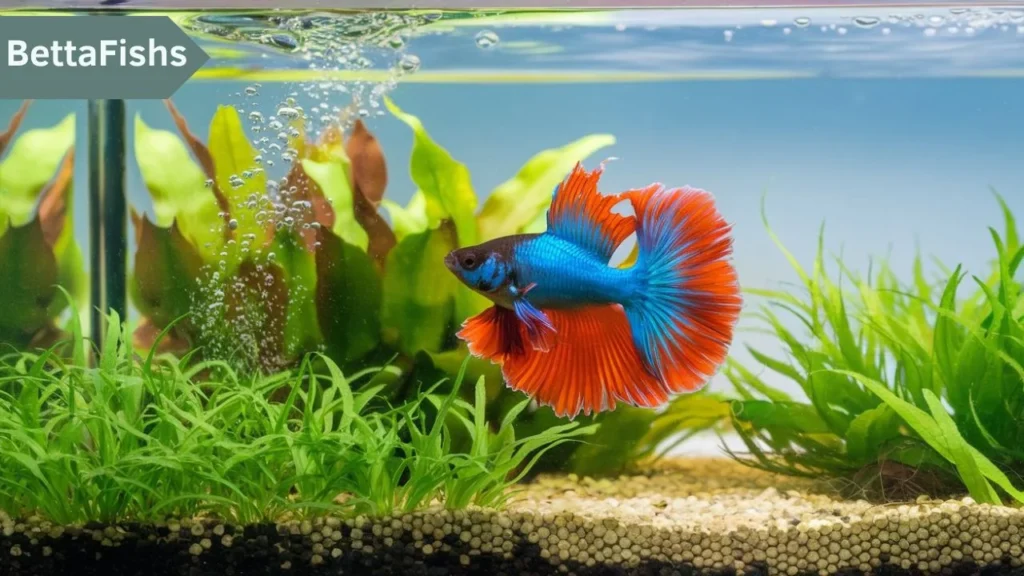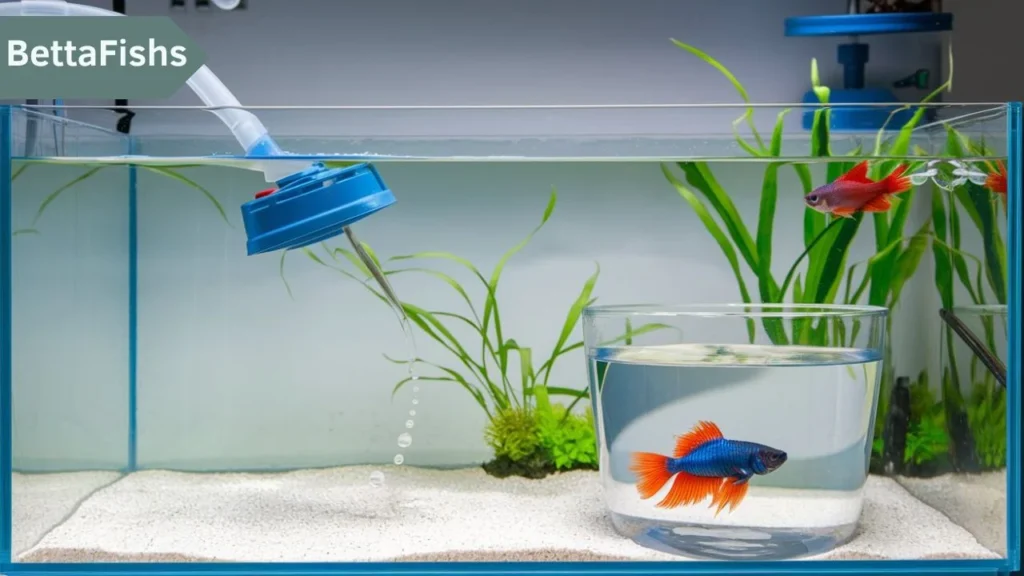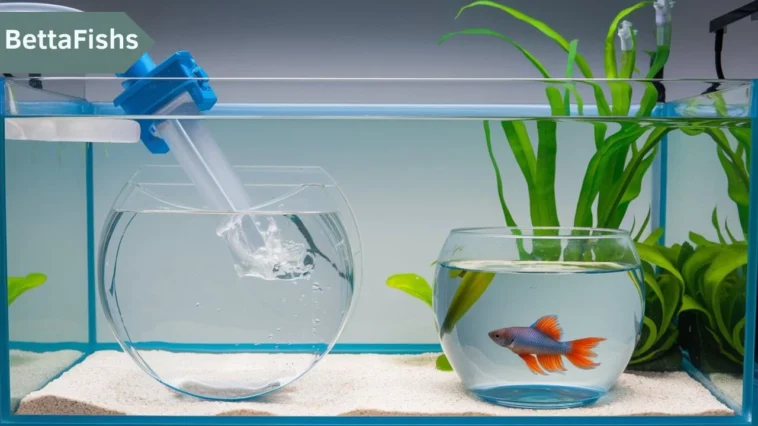Betta fish, with their brilliant colors and flowing fins, are a favorite option among aquarium hobbyists. However, maintaining a healthy environment for your Betta is crucial, and one of the most important aspects of this is water changes. In this guide, we’ll dive deep into ” Betta fish water change schedule ” and the essentials of creating and sticking to a Betta fish water change schedule to keep your aquatic friend happy and healthy.
Why Are Water Changes Important for Betta Fish?
Maintaining Water Quality
Water quality is paramount in ensuring the well-being of your Betta fish. Over time, harmful chemicals such as ammonia, nitrites, and nitrates build up in the tank. These toxins can lead to stress, illness, and even death if not properly managed.
Prevention of Disease
Regular water changes help prevent diseases by removing waste and other harmful substances from the tank. This creates a healthier environment where your Betta can thrive without the risk of infections or illnesses.
Promoting Growth and Longevity
Clean water promotes better growth and a longer life for your Betta fish. Regular water changes ensure that your fish has the best environment possible to live a healthy, vibrant life.
How Often Should You Change Betta Fish Water?
Weekly Water Changes
For most Betta tanks, a weekly water change is recommended. This routine helps maintain water quality and keeps the environment stable, reducing the stress on your Betta.
Daily Maintenance
While full water changes are done weekly, it’s essential to check the water daily. Remove any uneaten food, debris, and waste to prevent the accumulation of harmful substances.
Small Tanks vs. Large Tanks
The size of your tank also dictates how often you should change the water. Smaller tanks (under 5 gallons) may require more frequent changes, while larger tanks can often go a bit longer between changes.
The Step-by-Step Guide to Changing Betta Fish Water
Gather Your Supplies
Before you start, make sure you have everything you need: a clean bucket, a siphon or gravel vacuum, a water conditioner, and a thermometer.
Prepare the New Water
Always prepare the new water before removing the old water from the tank. Ensure that the water temperature matches the tank’s temperature, and add a water conditioner to neutralize chlorine and chloramines.
Remove the Old Water
Use a siphon or gravel vacuum to remove 25-50% of the water from the tank. Be careful not to disturb your Betta too much during this process.
Clean the Tank (Optional)
If needed, gently clean the sides of the tank and any decorations. Avoid using soap or harsh chemicals; a simple scrub with an algae pad will suffice.
Add the New Water
Slowly add the prepared water back into the tank, being mindful of the temperature. Pouring the water slowly helps prevent stress on your Betta.

Signs That Your Betta Needs an Immediate Water Change
Cloudy Water
If the water in your tank becomes cloudy, it’s a sign that a water change is needed. Cloudy water indicates a high level of waste and bacteria that can be harmful to your Betta.
Foul Odor
A strong, unpleasant smell from your tank is another clear indicator that the water needs to be changed immediately.
Behavioral Changes in Your Betta
If your Betta is acting lethargic, not eating, or showing signs of stress, it could be due to poor water quality. In such cases, perform a water change right away.
Nitrogen Cycle in Your Betta Tank
What is the Nitrogen Cycle?
The nitrogen cycle is the process by which beneficial bacteria break down waste products in the tank. Ammonia from fish waste is converted into nitrites and then into nitrates, which are less harmful to fish.
Cycling a New Tank
Before introducing a Betta to a new tank, it’s crucial to cycle the tank. This means allowing the nitrogen cycle to establish, which can take several weeks. During this time, monitor ammonia, nitrite, and nitrate levels closely.
Common Mistakes to Avoid When Changing Betta Fish Water
Changing Too Much Water at Once
Changing too much water at once can shock your Betta and disrupt the balance of the tank’s ecosystem. Stick to changing 25-50% of the water unless there’s a critical need.
Not Using a Water Conditioner
Tap water contains chlorine and chloramines, which are harmful to Betta fish. Always use a water conditioner to neutralize these chemicals before adding new water to the tank.
Using Water of the Wrong Temperature
Water that’s too cold or too hot can stress your Betta and even cause shock. Always ensure that the new water matches the tank’s temperature closely.
The Role of Plants in Betta Fish Tanks
Natural Filtration
Live plants can help filter the water naturally, absorbing some of the waste products and providing oxygen. This can reduce the frequency of water changes slightly but doesn’t eliminate the need for them.
Creating a Balanced Ecosystem
Plants create a more natural environment for your Betta, which can reduce stress and make your fish feel more at home.
How to Handle Emergencies: When a Betta Fish is Sick
Increase Water Changes
If your Betta is sick, increasing the frequency of water changes can help reduce stress and improve water quality, giving your fish the best chance of recovery.
Isolate the Betta
In cases of illness, consider moving your Betta to a hospital tank with pristine water conditions. This can prevent the spread of disease and allow for targeted treatment.
How to Make Water Changes Easier
Use a Gravel Vacuum
A gravel vacuum makes it easier to clean the tank while changing the water, helping to remove debris and waste from the substrate.
Automated Water Change Systems
For those with multiple tanks or larger setups, an automated water change system can save time and ensure consistent maintenance.

Tips for Traveling Betta Owners
Pre-Change Before Leaving
If you’re going away, do a water change right before you leave to ensure your Betta has clean water while you’re gone.
Use an Automatic Feeder
An automatic feeder can ensure your Betta gets regular meals while you’re away, reducing the need for someone to check on the tank daily.
Conclusion
Regular water changes are the cornerstone of maintaining a healthy environment for your Betta fish. By following a consistent water change schedule and monitoring water quality, you’ll ensure that your Betta thrives, showing off its beautiful colors and lively personality. Remember, the key to a happy Betta is clean water and a well-maintained tank.
FAQs
1. How often should I change the water in a Betta fish tank?
A: It’s recommended to change 25-50% of the water weekly, but small daily maintenance tasks like removing uneaten food can help maintain water quality.
2. Can I use tap water for my Betta fish?
A: Yes, you can use tap water, but you must treat it with a water conditioner to neutralize harmful chemicals like chlorine.
3. What happens if I don’t change the water in my Betta tank?
A: If you don’t change the water, toxins like ammonia and nitrites can build up, leading to stress, illness, and potentially the death of your Betta.
4. Can I change all the water in the Betta tank at once?
A: It’s not recommended to change all the water at once as it can shock your Betta and disrupt the tank’s ecosystem. Stick to changing 25-50% of the water.
5. What should I do if my Betta fish’s water is cloudy?
A: Cloudy water is a sign of poor water quality. Perform a water change immediately and check the tank’s filtration system.





9 Comments
Leave a Reply9 Pings & Trackbacks
Pingback:Betta fish tank pH levels
Pingback:Betta fish in 2.5 gallon tank?
Pingback:What size tank does a betta fish need?
Pingback:Betta fish tank setup
Pingback:Do betta fish need a bubbler?
Pingback:How much room do Betta fish need?
Pingback:What size tank does a Betta fish need?
Pingback:Do Betta fish get lonely?
Pingback:Do Betta fish hibernate?